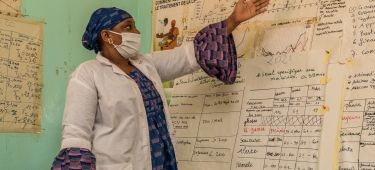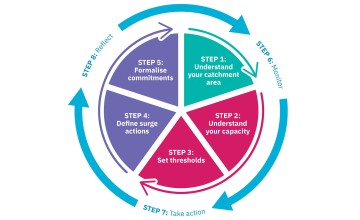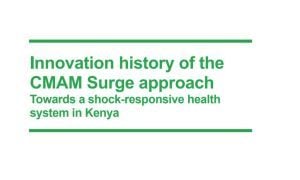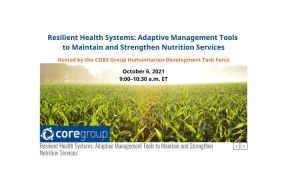
Read our 2023 annual report

Knowledge Hub

The Surge Approach
Overview
This page was initially created as a point of reference on the ‘CMAM Surge’ approach, to support practitioners to adapt, set-up, and implement the approach. Given the rapid scale up of the approach across increasingly diverse contexts, there was a need to ensure that technical integrity of the approach was maintained and that learning was captured and used to further strengthen and refine the approach. In July 2023, an updated Orientation Guide was launched.
The 'Surge Approach' is the updated name for the Community Management of Acute Malnutrition (CMAM) Surge approach, reflecting how the approach can also be used to better manage peaks in other common child illnesses. This page aims to facilitate a community of learning; with access to tools, orientation guides, evaluations and publications.
What is the Surge Approach?
The ‘CMAM Surge’ approach was first proposed to help the health system more effectively deliver services for children with acute malnutrition during periods of peak demand/high caseloads. Since 2020, the same approach was applied in several contexts to better manage peaks in other childhood illnesses and referred to as ‘Health Surge’. The overall aim of the Surge Approach is to make the health system more resilient over time, equipping it to cope with periodic peaks in demand for essential nutrition and child health services - when the potential to save lives is often greatest - without undermining the capacity and accountability of government health actors. In this way, it can contribute to building health system shock responsiveness.
The Surge Approach complements routine child health and nutrition services by improving health staffs’ use of facility data and knowledge of the local context to better anticipate, plan for, respond to, and bounce back from these increases in demand for common child illness treatment services.
The terms ‘CMAM Surge’ and ‘Health Surge’ will be used if referring to specific learning related to either of these approaches; otherwise, the term ‘Surge Approach’ will be used going forward.
The Eight Steps of the Surge Approach
The Surge Approach uses eight steps to help government health teams respond to relative changes in capacity and caseloads. The eight steps are summarised below.

- 1
Understand your catchment area
The health facility (HF) team create a seasonal and events calendar and analyse historical trends in common child illnesses (including acute malnutrition) using wall charts. This information is used to identify potential risk factors that drive peak periods in service demand of the priority child illness(es) in that community.
- 2
Understand your capacity
The HF team reviews their capacity to manage essential child health and nutrition services during normal times and peak periods; identifying capacity gaps to be addressed. They then agree on the number of consultations for the priority child illness(es), which they consider to be ‘manageable’ each month with existing capacity.
- 3
Set thresholds
The HF team agrees on thresholds or ‘cut off point’s defined as the number of consultations of the priority child illness(es) that would push the health workers into the alert and the serious phases. The thresholds indicate the increasing levels of support that would be required to protect the quality of service delivery.
- 4
Define Surge actions
The HF team outlines a surge action plan. The action plan includes: actions to help prepare for expected peaks in service demand during normal times; internal adaptations for the alert phase and external support needs for the serious phase. Actions which have a cost implication are noted so commitments from stakeholders to resource the actions can be agreed in Step 5.
- 5
Formalise commitments
The HF team, other community stakeholders and the DHMT agree how the actions in the surge action plan will be resourced and who will be responsible to ensure they are delivered swiftly when thresholds are passed. The DHMT may make further agreements with regional stakeholders and non-government actors to support them to deliver the support to HF.
- 6
Monitor
The HF team monitors the seasonal and events calendar noting any deviations from what was expected (e.g. delayed rains, sudden population movement, mass screening campaign). The actual number of consultations for the priority child illness(es) each month are plotted and compared against the set thresholds. Trends in other common child illnesses are also monitored.
- 7
Take action
Ongoing review is critical to the success of CMAM Surge. Capacity, thresholds and Surge actions are all reviewed on an ongoing basis, and adapted as needed. In addition, the HF completes ‘post-Surge’ evaluations to review the impact and efficiency of a Surge response.
- 8
Reflect
Ongoing review and reflection are critical. The HF team must regularly review their capacity, thresholds and surge action plan and adapt as needed; also a simple ‘post-surge’ evaluation should be completed to review the impact and efficiency of any surge response.
The status of each health facility is also monitored by the higher-level health authority (e.g. district health management team) that can, in turn, monitor trends across a wider geographic area and call for higher-level regional or national response if the situation continues to deteriorate.
Health Surge
The ‘Health Surge’ approach was the term initially used when piloting the application of the eight ‘CMAM Surge’ steps to support the management of other common child illnesses. It was first piloted in Sierra Leone in 2017 to support health workers manage peaks of malaria consultations. Key learning documents on ‘Health Surge’ pilots can be found in the Learning and Evaluations section below.
The updated orientation guide is designed to promote flexibility and might add value in contexts where there are largely predictable, seasonal fluctuations in the number of children presenting to the health facility with common child illnesses, such as acute malnutrition, malaria, diarrhoea or acute respiratory infection.
Surge Approach Mapping
‘CMAM Surge’ is currently being implemented in 12 countries with technical assistance to governments provided by multiple NGO and UN partners. Concern has introduced and supported implementation of the Surge Approach in more than six country programmes. The map below illustrates to the best of our knowledge where the ‘CMAM Surge’ approach has been implemented. Please contact [email protected] if you have any updated information.
Burundi
In 2018 a CMAM Surge pilot was set up and supported by Concern Worldwide, but is not currently active.
Burkina Faso
CMAM Surge has been implemented since 2017, supported by Action Against Hunger (ACF) and Terre des Hommes (TDH).
Cameroon
In 2019 CMAM Surge was set up in one health facility with the support of the French Red Cross (CRF).
Chad
CMAM Surge has been implemented since 2018, supported by Concern Worldwide, French Red Cross (CRF) and Action Against Hunger (ACF).
Kenya
The first pilot of CMAM Surge was set up and supported by Concern Worldwide in 2012. Subsequently there has been expansion and support by Action Against Hunger (ACF), Christian Relief Services (CRS), Kenyan Red Cross, World Vision, Save the Children International (SCI), and International Rescue Committee (IRC). The IMAM Surge toolkit was later integrated into county strategic planning documents including the County Nutrition Action Plan (2019-2023) and the County Integrated Development Plan (2018-2022).
Mali
CMAM Surge has been implemented since 2017. Since then, there has been expansion and support by Action Against Hunger (ACF), Alima, ACTED, COOPI, International Rescue Committee (IRC) and Terre des Hommes (TdH). There is a national CMAM Surge Taskforce led by the Ministry of Health with the technical support of Save the Children International (SCI) to support coordination. In 2019, CMAM Surge guidelines adapted to the Malian context were published.
Ethiopia
CMAM Surge has been implemented since 2017, supported by Concern Worldwide and GOAL.
Mauritania
CMAM Surge has been implemented since 2018, supported by the French Red Cross (CRF) and Action Against Hunger (ACF).
Niger
CMAM Surge has been implemented since 2016, supported by Concern Worldwide. Since then, there has been expansion and support by ACF, ALIMA, COOPI, GOAL, HELP, IRC and SCI. In 2019 a national CMAM Surge Taskforce was established by the Ministry of Health with the technical support of Concern. In 2021, a national strategy for the scale up of CMAM Surge was validated and in 2023, CMAM Surge was integrated into the national CMAM protocol.
Nigeria
In 2022, CMAM Surge pilot was set up and supported by the International Rescue Committee (IRC).
Pakistan
In 2018, CMAM Surge was set up with the support of Concern Worldwide and the World Food Programme (WFP).
Senegal
In 2018, CMAM Surge was set up and supported by Action Against Hunger (ACF), but is not currently active.
Somalia
In 2021, a CMAM Surge pilot was set up by Concern Worldwide, in collaboration with Action Against Hunger (ACF).
South Sudan
In 2021, an adapted CMAM Surge pilot was set up by Concern Worldwide in one health facility.
Uganda
In 2016 CMAM Surge was set up and supported by Concern Worldwide, and subsequently is supported by UNICEF.
Sudan
In 2022, a CMAM Surge pilot was set up with the support of Concern Worldwide.
Implementation guides and tools
Surge Approach: Orientation Guide (updated)
Incorporates learning from pilots and innovations based on ongoing work from Concern Worldwide and other actors including Ministries of Health and other non-governmental organisations. The guide and tools have been designed to promote flexibility to choose the components of the approach that add value based on the health system set up and existing resources.
Concern Worldwide welcomes feedback on the updated guide and comments can be sent to [email protected].
**Please note: Annex 3 and French version of the Orientation Guide will be available soon**
Learning and evaluations
Since the first ‘CMAM Surge’ pilot in Kenya in 2012, a wealth of experience and learning across a variety of contexts has been generated. Concern has supported several learning reviews and evaluations of ‘CMAM Surge’ and ‘Health Surge’ in order to inform adaptations of the approach as well as investment in scale-up. Some key resources are available for download below.
Evaluations
Learning Papers
CMAM Surge and Cost Effectiveness

External resources
CMAM Surge Field Exchange Series 2021
In 2021, a series of articles were published on CMAM Surge in the Emergency Nutrition Network’s (ENN) Field Exchange journal. This seven article series summarises the key lessons learnt over the past eight years and the way forward for the Surge approach. The full articles can be found on ENNs website:
- CMAM Surge – Setting the Scene
- Implementing IMAM (CMAM) Surge approach – experience from Kenya
- The role of coordination in CMAM Surge scale-up in West and Central Francophone Africa
- CMAM Surge – understanding costs and potential contribution to CMAM’s cost-effectiveness
- Expanding CMAM Surge beyond nutrition – towards a broader Health Surge approach
- CMAM Surge: lessons on the journey so far
In addition, Concern has provided technical support and collaborated with a number of key stakeholders in the production of other learning resources:
Coordination Mechanisms
Concern chaired the Global CMAM Surge Technical Working Group (Global TWG). The purpose of the Global TWG was to ensure coordination of CMAM Surge activities to maximise quality, effectiveness, and learning. The membership included a diverse group of CMAM / Health Surge stakeholders including Ministry of Health representatives, donors, and non-governmental organisations. The Global TWG was established in October 2020, and reached the end of its term in May 2023. Going forward it is encouraged that, where relevant, the Surge Approach is included in other health and nutrition forums for discussion.
Concern is co-lead of the West Africa Region CMAM Surge Taskforce with the French Red Cross (CRF). The role of coordination in the CMAM Surge scale-up in West and Central Francophone Africa is described in an article for Field Exchange. Since 2021, rather than routine coordination meetings, learning webinars have been organised. A summary of the 2021 webinars is available below.
Concern is co-lead of the West Africa Region CMAM Surge Taskforce with the French Red Cross (CRF). The role of coordination in the CMAM Surge scale-up in West and Central Francophone Africa is described in an article for Field Exchange. Since 2021, rather than routine coordination meetings, learning webinars have been organised. A summary of the 2021 webinars is available below.
National level CMAM Surge Taskforces have also been established in Mali and Niger. Led by Save the Children and Concern Worldwide respectively, in collaboration with Ministries of Health.
Contact us
If you have any question related to the Surge Approach, please contact: [email protected].
This publication covers aid activities implemented with the financial assistance of several donors, including the European Civil Protection and Humanitarian Aid Operations Department (ECHO), USAID, Irish Aid and others. The ideas, opinions and comments herein are entirely the responsibility of the author(s) and do not necessarily represent or reflect the policies of any donors.




